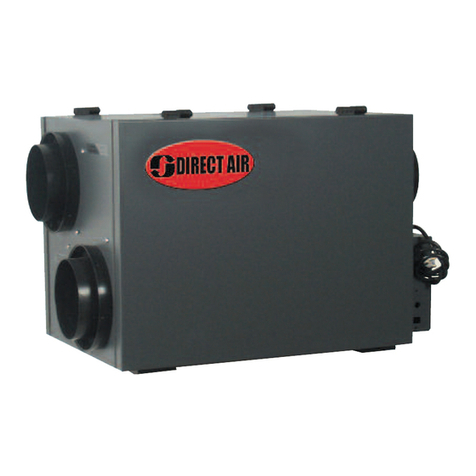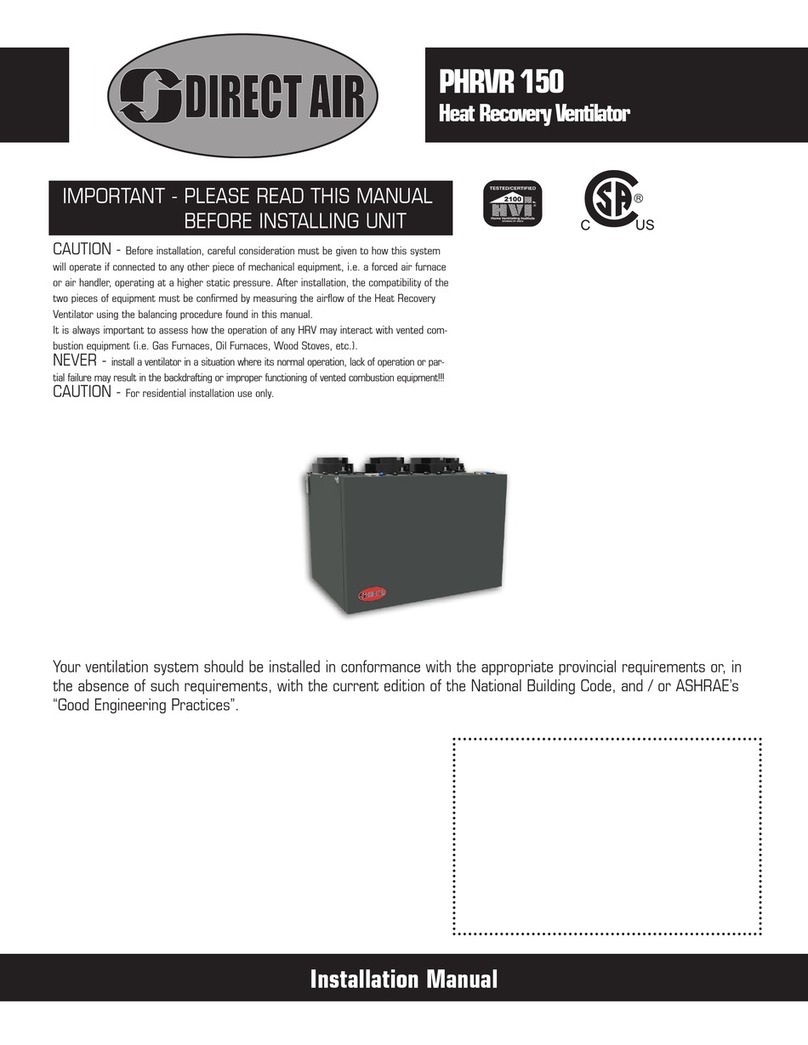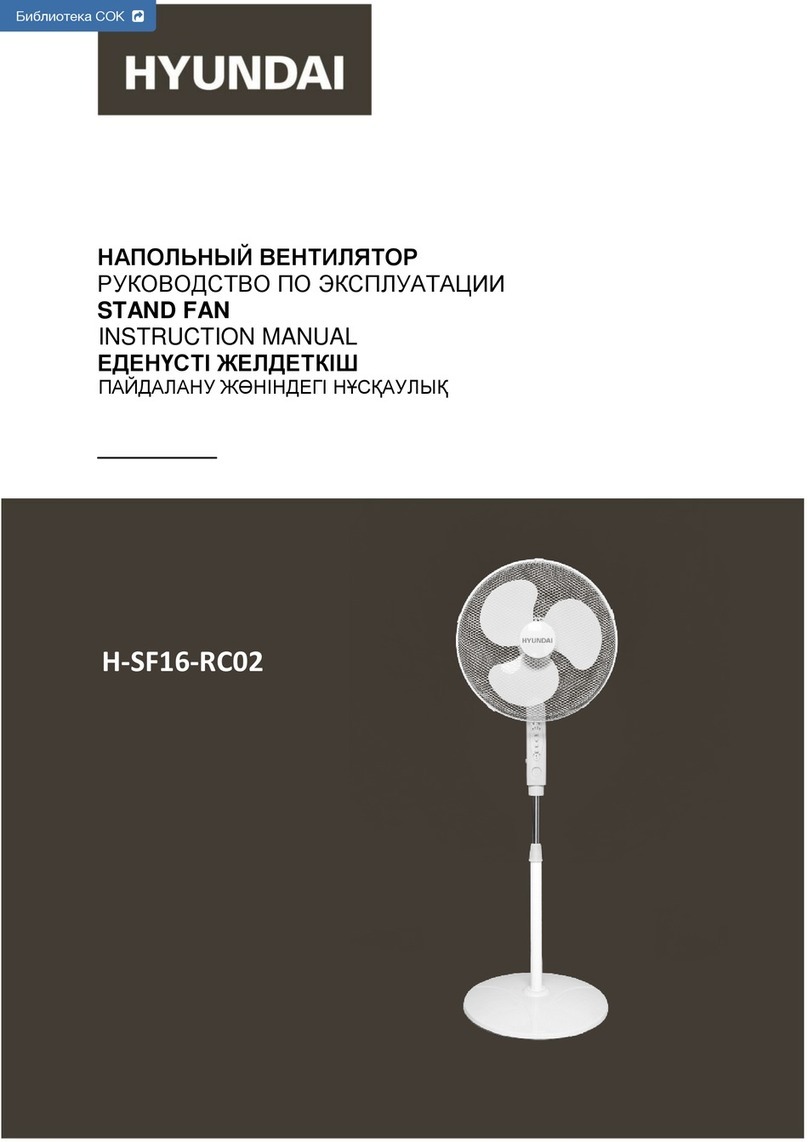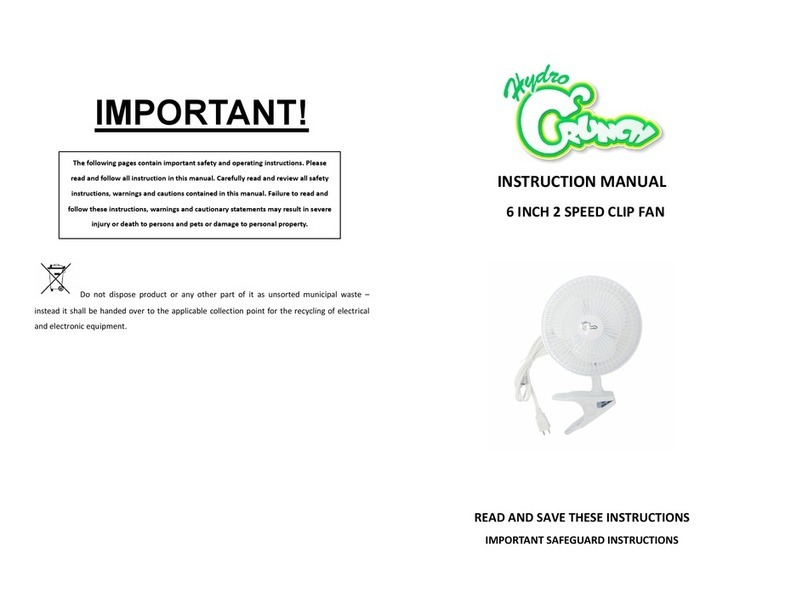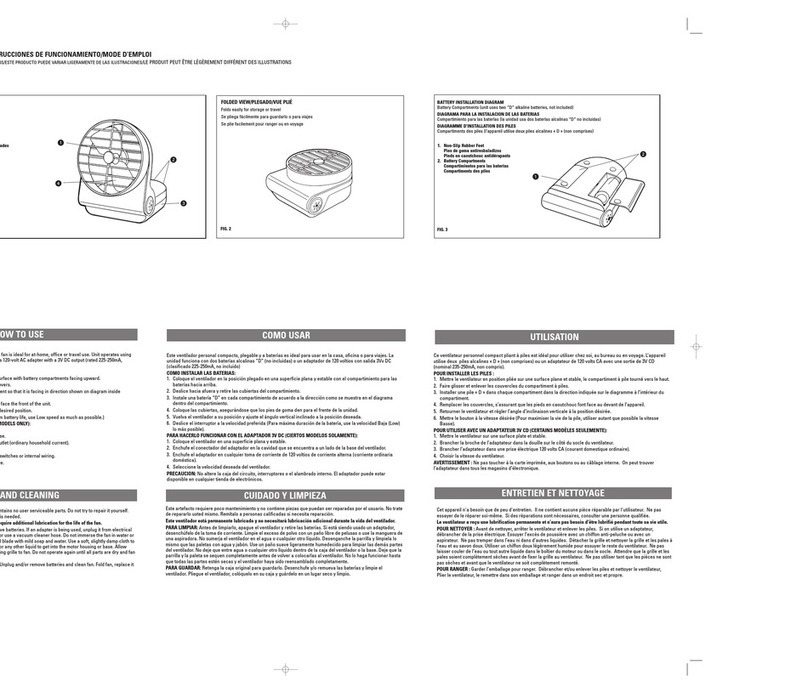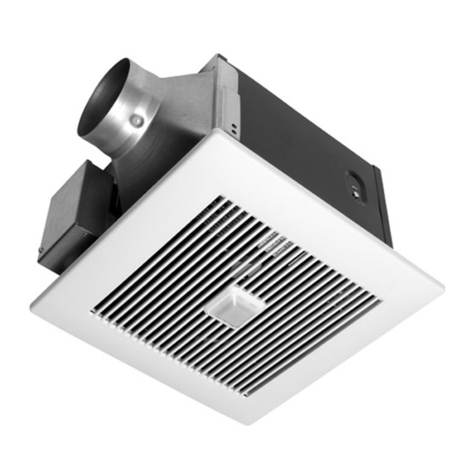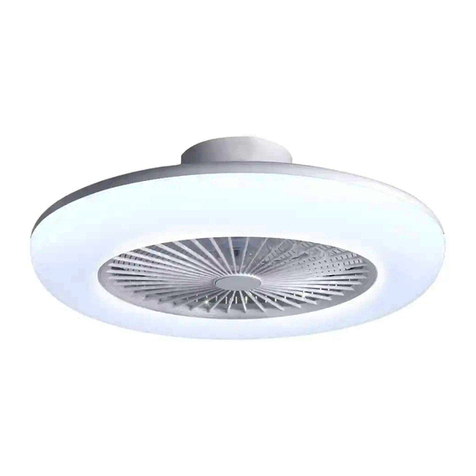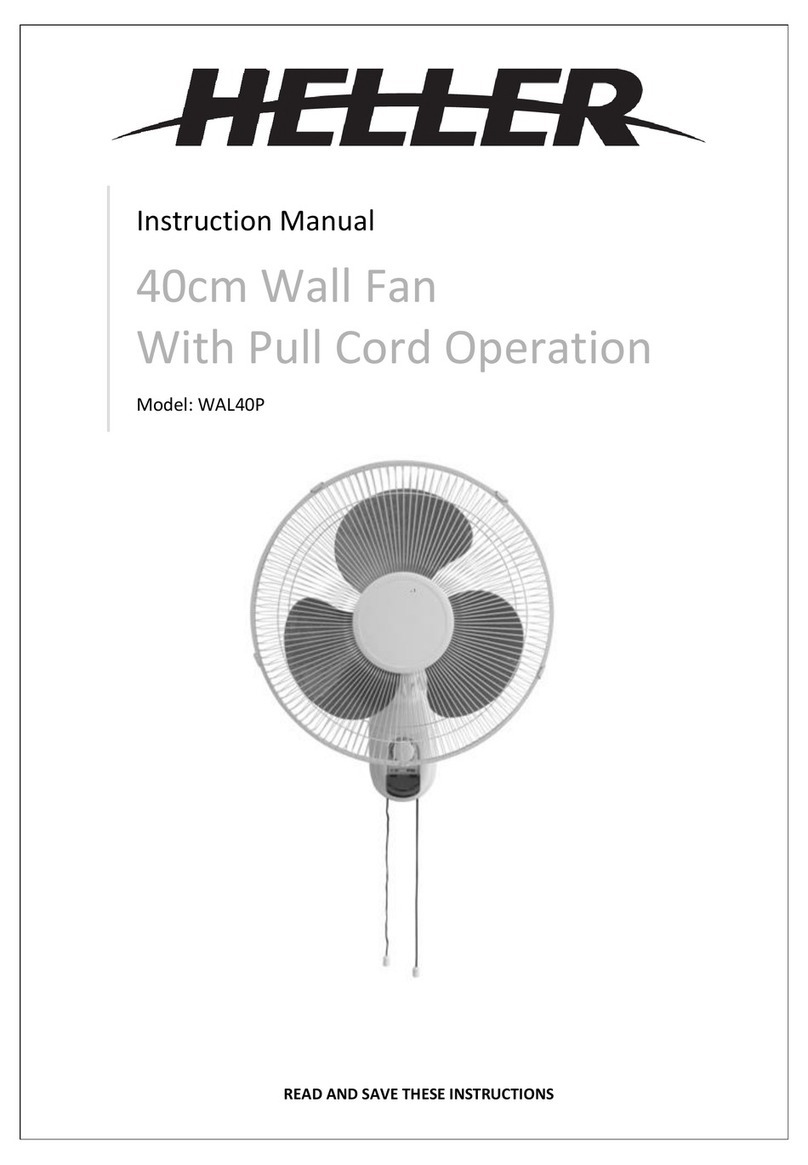Direct Air PHRVR100 ES User manual

Your ventilation system should be installed in conformance with the appropriate provincial requirements or, in
the absence of such requirements, with the current edition of the National Building Code, and / or ASHRAE’s
“Good Engineering Practices”.
IMPORTANT - PLEASE READ THIS MANUAL
BEFORE INSTALLING UNIT
CAUTION - Before installation, careful consideration must be given to how this system
will operate if connected to any other piece of mechanical equipment, i.e. a forced air furnace
or air handler, operating at a higher static pressure. After installation, the compatibility of the
two pieces of equipment must be confirmed by measuring the airflow of the Heat Recovery
Ventilator using the balancing procedure found in this manual.
It is always important to assess how the operation of any HRV may interact with vented com-
bustion equipment (i.e. Gas Furnaces, Oil Furnaces, Wood Stoves, etc.).
NEVER - install a ventilator in a situation where its normal operation, lack of operation or par-
tial failure may result in the backdrafting or improper functioning of vented combustion equipment!!!
CAUTION - For residential installation use only.
PHRVR100 ES, 104 ES
Heat Recovery Ventilator
Installation Manual

2
TABLE OF CONTENTS
GUIDE SPECIFICATION SHEETS
PHRVR100 ES .......................................................................3
PHRVR104 ES .......................................................................5
DETERMINING YOUR AIRFLOW REQUIREMENT ..................................................... 7
INSTALLATION EXAMPLES
Fully dedicated system ................................................................ 8
Partially dedicated system .............................................................. 9
Simplified Installation ................................................................ 10
EXTERIOR DUCTING INSTALLATION
Weatherhood Location ................................................................ 11
Installing the ducting to the weatherhood .................................................. 11
INTERIOR DUCTING INSTALLATION
General Tips ....................................................................... 12
Installing duct to HRV ................................................................ 12
Supply & Exhaust Air Grilles Location...................................................... 12
HRV INSTALLATION ........................................................................ 13
AIRFLOW ADJUSTMENT & BALANCING
General preparation ................................................................. 15
Adjusting airflow using integrated balancing system ........................................... 15
Balancing steps .................................................................... 18
LOW VOLTAGE CONTROL SYSTEMS ............................................................. 17
WIRING DIAGRAM ......................................................................... 18
TROUBLESHOOTING .........................................................................20
HRV MAINTENANCE CHART ...................................................................21
Note Warning/
Important
note
Information Technical
information Practical tip

3
THE PHRVR100 ES HRV:
Powerful things can come in a small package!
PHRVR100 ES is a compact HRV specially designed for
small residential and multi-residential applications such as
condominiums and apartment buildings that require up to
100 CFM of continuous principal ventilation. With its flexible
and compact top port design incorporating the 5" oval
collars with integrated airflow measurement and wall
bracket, it can be installed in small spaces such as 24"
closets or above the hot water heater.
FEATURES
• 5" (125mm) oval duct connections with integrated airflow
measurement
• Removable screw terminal for easy connection
• Lightweight: only 39 lbs (17.7 kg) including core
• Super compact size
• Top port design fits in tight spaces
• Includes wall bracket
• Aluminum heat recovery core
• Multiple speed operation
• Internal recirculation defrost
OPTIONAL CONTROLS:
Speed control for Normal and Reduced speed standard on unit.
Other operating modes available from optional controls below.
• Dehumidistat 1 – Dehumidistat
• RTS20 – 20 minute timer over-ride
• RTS5 – 20/40/60 minute timer
• EDF1R – Triple function wall control
• DIR-TS – Multi-function control
• DIR-DG – Multi-function Dehumidistat
MOTORS: Two (2) German-manufactured, factory-balanced
EBM motors with backward curved blades. Motors come with
permanently lubricated, sealed ball-bearings to guarantee
long life and maintenance-free operation. Covered by a seven
(7) year warranty.
HEAT RECOVERY CORE: Aluminum heat recovery core covered
by a limited lifetime warranty. Core dimensions are 8.5" x 8.5"
(216 x 216 mm) with a 12" (305 mm) depth. Our heat
exchangers are designed and manufactured to withstand
extreme temperature variations.
FROST PREVENTION SYSTEM: The PHRVR100 ES
incorporates a unique and quiet internal recirculation defrost
that does not depressurize the home during the defrost cycle.
A preset defrost sequence is activated when the outdoor
temperature falls below 23° F (-5° C) and automatically
adjusts itself based on operating conditions. The fan speed is
also adjusted automatically to provide a smooth and quiet
transition between Ventilation & Defrost mode.
SERVICEABILITY: All serviceable internal components, including
core, filters, motors and electronic board are easily accessible
and can be fully removed in under 5 minutes for complete
service. A 12" (305 mm) clearance from the front of the unit is
recommended to fully remove the core and other internal
components.
DUCT CONNECTIONS: 5" (125mm) Oval plastic duct
connections with integrated balancing damper and airflow
measurement ports.
CASE: 24 gauge galvanized steel. Baked powder-coated paint
for a superior adhesion and resistance.
INSULATION: Cabinet is fully insulated with 1" (25 mm) high
density expanded polystyrene.
FILTERS: Two (2) washable electrostatic panel type air filters,
8.5" (216mm) x 12.5" (318 mm) x 0.125" (3mm).
DRAIN: 1/2" (13mm) OD (outside diameter) drain spout
provided, entire bottom of unit covered by drain pan.
WARRANTY: Limited lifetime on aluminum core, 7 year on
motors, and 5 year on parts.
PHRVR100 ES
Heat Recovery Ventilator

4
Dimensions & Airflow - All units feature three foot plug-in power cord with 3-prong plug.
• 12" (305mm) of clear-
ance in the front is rec-
ommended for removal
of core
Stale Air
To Outside
Stale Air
From Inside
Fresh Air
From Outside
Fresh Air
To Inside
22.4" (569 mm)
21.5" (546 mm) 14.5" (368 mm)
15" (381 mm)
17.9" (455 mm)
15 5/8" (397 mm)
Specifications
• Model: PHRVR100 ES
• Total assembled weight: 39 lbs (17.7 kg)
• Mounting: Wall bracket included as standard
• Motors: ebm motors with backward curved
blades
• Supply & Exhaust ducts: 5" (125mm) oval
• Insulated with high density polystyrene foam.
• Core: Aluminum
8.5" (216mm) x 8.5" (216mm) x 12" (305mm)
• Filters: 2 washable electrostatic filters 8.5"
(216mm) x 12.5" (318mm) x 0.125" (3mm)
• Cabinet: 24 ga. steel w/powder coat finish
• Electrical requirements:
Volts Frequency Amps
120V 60Hz 1.4A
3' plug-in power cord w/ 3-prong plug
Pa in wg L/s cfm L/s cfm L/s cfm
25 0.1 61 129 62 131 62 131
50 0.2 57 121 58 123 58 123
75 0.3 53 112 54 114 54 114
100 0.4 49 104 50 106 50 106
125 0.5 45 95 46 97 46 97
150 0.6 42 89 42 89 42 89
175 0.7 38 81 38 81 38 81
200 0.8 33 70 34 72 33 70
225 0.9 28 59 29 61 28 59
250 1.0 23 49 23 49 23 49
EXT. STATIC
PRESSURE
NET SUPPLY
AIR FLOW
GROSS AIR FLOW
SUPPLY EXHAUST
°C °F L/s cfm
Heating 0 32 30 64 50 65 69 0.02
0 32 38 81 65 63 68 -0.01
0 32 48 102 100 60 66 0.00
-25 -13 31 66 65 62 65 0.04
SUPPLY
TEMPERATURE
NET
AIRFLOW
Energy Performance
POWER
CONSUMED
WATTS
SENSIBLE
RECOVERY
EFFICIENCY
APPARENT
SENSIBLE
EFFECTIVENESS
NORMAL SPEED
LATENT
RECOVERY/MOISTURE
TRANSFER
Airow (L/s)
Airow (cfm)
Static Pressure (in H2O)
Static Pressure (Pa)
0 25 50 75 100 125 150 175 200
0 12 24 35 47 59 71 82 94
0.0
0.2
0.4
0.6
0.8
1.0
0.0
50
100
150
200
250
Reduced Speed
Med Speed
Normal Speed
3
2
1
1
3
2

5
THE PHRVR104 ES HRV:
Powerful things can come in a small package!
PHRVR104 ES is a compact HRV specially designed for
small residential and multi-residential applications such as
condominiums and apartment buildings that require up to
100 CFM of continuous principal ventilation. With its flexible
and compact top port design incorporating the 5" oval
collars with integrated airflow measurement and wall
bracket, it can be installed in small spaces such as 24"
closets or above the hot water heater.
The PHRVR104 ES is also equipped with the Manually
activated extra hight speed function to temporarily increase
its exhaust capacity when needed; for example, when
bathrooms or kitchens are exhausted with the use of an HRV
instead of conventional methods.
FEATURES
• Maually activated extra high speed function boosts exhaust
capacity by up to 50%
• 5" (125mm) oval duct connections with integrated airflow
measurement
• Removable screw terminal for easy connection
• Lightweight: only 39 lbs (17.7 kg) including core
• Super compact size
• Top port design fits in tight spaces
• Includes wall bracket
• Aluminum heat recovery core
• Multiple speed operation
• Internal recirculation defrost
OPTIONAL CONTROLS:
Speed control for Normal and Reduced speed standard on unit.
Other operating modes available from optional controls below.
• DIR-TS – Programmable Touch Screen Wall
Control
• Dehumidistat 1 – Dehumidistat
• RTS20 – 20 minute timer over-ride
• RTS5 – 20/40/60 minute timer
• EDF1R – Triple function wall control
MOTORS: Two (2) German-manufactured, factory-balanced
EBM motors with backward curved blades. Motors come with
permanently lubricated, sealed ball-bearings to guarantee
long life and maintenance-free operation. Covered by a seven
(7) year warranty.
HEAT RECOVERY CORE: Aluminum heat recovery core covered
by a limited lifetime warranty. Core dimensions are 8.5" x 8.5"
(216 x 216 mm) with a 12" (305 mm) depth. Our heat
exchangers are designed and manufactured to withstand
extreme temperature variations.
FROST PREVENTION SYSTEM: The PHRVR104 ES
incorporates a unique and quiet internal recirculation defrost
that does not depressurize the home during the defrost cycle.
A preset defrost sequence is activated when the outdoor
temperature falls below 23° F (-5° C) and automatically
adjusts itself based on operating conditions. The fan speed is
also adjusted automatically to provide a smooth and quiet
transition between Ventilation & Defrost mode.
SERVICEABILITY: All serviceable internal components, including
core, filters, motors and electronic board are easily accessible
and can be fully removed in under 5 minutes for complete
service. A 12" (305 mm) clearance from the front of the unit is
recommended to fully remove the core and other internal
components.
DUCT CONNECTIONS: 5" (125mm) Oval plastic duct
connections with integrated balancing damper and airflow
measurement ports.
CASE: 24 gauge galvanized steel. Baked powder-coated paint
for a superior adhesion and resistance.
INSULATION: Cabinet is fully insulated with 1" (25 mm) high
density expanded polystyrene.
FILTERS: Two (2) washable electrostatic panel type air filters,
8.5" (216mm) x 12.5" (318 mm) x 0.125" (3mm).
DRAIN: 1/2" (13mm) OD (outside diameter) drain spout
provided, entire bottom of unit covered by drain pan.
WARRANTY: Limited lifetime on aluminum core, 7 year on
motors, and 5 year on parts.
PHRVR104 ES
Heat Recovery Ventilator

6
Dimensions & Airflow - All units feature three foot plug-in power cord with 3-prong plug.
• 12" (305mm) of clear-
ance in the front is rec-
ommended for removal
of core
Stale Air
To Outside
Stale Air
From Inside
Fresh Air
From Outside
Fresh Air
To Inside
22.4" (569 mm)
21.5" (546 mm) 14.5" (368 mm)
15" (381 mm)
17.9" (455 mm)
15 5/8" (397 mm)
Specifications
• Model: PHRVR104 ES
• Total assembled weight: 39 lbs (17.7 kg)
• Mounting: Wall bracket included as standard
• Motors: Permanently sealed motors, backward
curved blades
• Supply & Exhaust ducts: 5" (125mm) oval
• Insulated with high density polystyrene foam.
• Core: Aluminum
8.5" (216mm) x 8.5" (216mm) x 12" (305mm)
• Filters: 2 washable electrostatic filters 8.5"
(216mm) x 12.5" (318mm) x 0.125" (3mm)
• Cabinet: 24 ga. steel w/powder coat finish
• Electrical requirements:
Volts Frequency Amps
120V 60Hz 1.4A
3' plug-in power cord w/ 3-prong plug
Pa in wg L/s cfm L/s cfm L/s cfm
25 0.1 61 129 62 131 62 131
50 0.2 57 121 58 123 58 123
75 0.3 53 112 54 114 54 114
100 0.4 49 104 50 106 50 106
125 0.5 45 95 46 97 46 97
150 0.6 42 89 42 89 42 89
175 0.7 38 81 38 81 38 81
200 0.8 33 70 34 72 33 70
225 0.9 28 59 29 61 28 59
250 1.0 23 49 23 49 23 49
EXT. STATIC
PRESSURE
NET SUPPLY
AIR FLOW
GROSS AIR FLOW
SUPPLY EXHAUST
°C °F L/s cfm
Heating 0 32 30 64 50 65 69 0.02
0 32 38 81 65 63 68 -0.01
0 32 48 102 100 60 66 0.00
-25 -13 31 66 65 62 65 0.04
SUPPLY
TEMPERATURE
NET
AIRFLOW
Ventilation Performance
Energy Performance
POWER
CONSUMED
WATTS
SENSIBLE
RECOVERY
EFFICIENCY
APPARENT
SENSIBLE
EFFECTIVENESS
NORMAL SPEED
0 25 50 75 100 125 150 175 200
0 12 24 35 47 59 71 82 94
0.0
0.2
0.4
0.6
0.8
1.0
0.0
50
100
150
200
250
Reduced Speed
Med Speed
Normal Speed
Turbo
4
3
2
1
1
4
3
2
LATENT
RECOVERY/MOISTURE
TRANSFER
Airow (L/s)
Airow (cfm)
Static Pressure (in H2O)
Static Pressure (Pa)

7
Room classification Number of rooms CFM (L/s)
CFM Required
Master bedroom x 10 L/s (20 CFM) =
Basement yes or no =
Bedrooms x 5 L/s (10 CFM) =
Living room x 5 L/s (10 CFM) =
Others x 5 L/s (10 CFM) =
Kitchen x 5 L/s (10 CFM) =
Bathroom x 5 L/s (10 CFM) =
Laundry room x 5 L/s (10 CFM) =
Utility room x 5 L/s (10 CFM) =
Total Ventilation Requirements (add last column ) =
if yes add 10 L/s (20 CFM)
if no = 0
1 CFM = 0.47 L/s
1 L/s = 2.13 CFM
Room Count Method
DETERMINING YOUR AIRFLOW REQUIREMENT
ASHRAE method
Ventilation Air requirements
Floor area Bedrooms
1 2 3 4 5
Ft2m2CFM L/s CFM L/s CFM L/s CFM L/s CFM L/s
<500 <47 30 128 38 18 45 21 53 25 60 28
501-1000 47-93 45 21 53 24 60 28 68 31 75 35
1001-1500 94-139 60 28 68 31 75 35 83 38 90 42
1501-2000 140-186 75 35 83 38 90 42 98 45 105 49
2001-2500 187-232 90 42 98 45 105 49 113 52 120 56
2501-3000 233-279 105 49 113 52 120 56 128 59 135 63
3001-3500 280-325 120 56 128 59 135 63 143 66 150 70
3501-4000 326-372 135 63 143 66 150 70 158 73 165 77
4001-4500 373-418 150 70 158 73 165 77 173 80 180 84
4501-5000 419-465 165 77 173 80 180 84 188 87 195 91
* ASHRAE 62.2-2016 Table 4.1, Ventilation and Acceptable Indoor Air Quality in Low-Rise Residential Buildings.
Bathroom: If the HRV is going to provide the required local exhaust ventilation for each bathroom with each a continuous 20 CFM
(10 L/s), this ventilation rate can be considered as part of the whole-building ventilation rate.

8
HRV ducting for fully Dedicated System
Stale air from inside
Outside
Fresh air to living areas
Fresh air from
outside
Stale air to
outside
INSTALLATION EXAMPLES
Example only – duct configuration may differ depending on the model.
FULLY DEDICATED SYSTEM
BEST FOR NEW CONSTRUCTION
1. Stale air is drawn from key areas of the home requiring local exhaust (bathroom,
kitchen, laundry room).
2. Fresh air is distributed directly to habitable rooms in the house (bedrooms, living
room)
3. The HRV’s airflow must be balanced after installation using the procedure found
in the section “AIRFLOW BALANCING”
Suggested installation for:
• Hydronic baseboard
• Inoor heating
• Electric baseboard
• Mini split heat pump
Benets: Provides the best
fresh air distribution in the
house; lowest operation cost
since the furnace/air handler
unit is not needed.

9
HRV/ Furnace ducting for Partially Dedicated System
INSTALLATION EXAMPLES (CONT'D)
DIRECT CONNECTION of the FRESH air to living area to the RETURN PLENUM
of the AIR HANDLER (Stale air drawn from key areas of home)
PARTIALLY DEDICATED SYSTEM (BETTER)
Suggested installation for:
• Central furnace (air
handling unit or central
air conditioners)
• When ducting fresh
air to living area is not
possible or practical,
i.e. expensive or when
the central AHU will
operate year-round.
Benets: Conditions the
fresh air prior to
distributing it throughout
the house
1. In order to provide proper distribution of the fresh air, it is recommended that
the furnace blower be set to run continuously or interconnected with HRV.
2. Stale air is drawn from key areas of the home (bathroom, kitchen, laundry
room).
3. Fresh air is supplied to the return air plenum of the furnace.
4. Due to the difference in pressure between the HRV and the equipment it is
being connected to the HRV’s airflow must be balanced on site, using the
procedure found in the section “AIRFLOW BALANCING”
Make sure the HRV is
capable of meeting the
required airow rate.
Stale air from inside
* Unit airflow should be balanced while HRV is on
“Normal” speed and furnace blower is running.
Outside
Fresh air
to living
areas
1 m (3' 3")
min.
recommended
Return
plenum
Stale air to
outside
Fresh air from
outside

10
Stale air from inside
Outside
Fresh air to
living areas
1 m (3' 3")
min.
recom-
mended
Cold air
return
HRV/ furnace for Simplified Installation
INSTALLATION EXAMPLES (CONT'D)
DIRECT CONNECTION of both the HRV SUPPLY AIR STREAM and EXHAUST AIR STREAM
to the FURNACE COLD AIR RETURN
SIMPLIFIED INSTALLATION
(GOOD)
(RETURN/RETURN METHOD)
Suggested installation for:
• When bathroom and kitchen
already have local exhaust
system
• May be suitable for
retrotting
Benets: Least expensive
installation type
1. Furnace blower must operate when ventilation from HRV is required. The furnace should
be set to run continuously or interlocked with HRV.
2. A minimum separation of 1m (39’’) is recommended between the two direct
connections.
3. In order to prevent exhausting any fresh air, the HRV’s exhaust air connection should be
upstream of the HRV’s supply air connection when ducting to the furnace’s cold air return.
4. Due to the difference in pressure between the HRV and the equipment it is being
connected to the HRV’s airflow must be balanced on site, using the procedure found in
the section “AIRFLOW BALANCING”
Stale air to
outside
Fresh air from
outside
* Unit airflow should be balanced while HRV is on
“Normal” speed and furnace blower is running.

11
EXTERIOR DUCTING INSTALLATION
WEATHERHOOD LOCATION
• Decide where your intake and exhaust hoods will be located.
Locating the Intake Weatherhood
• Should be located upstream (if there are prevailing winds) from the
exhaust outlet.
• At a minimum of 2m (6’) away from dryer vents and furnace exhaust
(medium or high efficiency furnaces), driveways, oil fill pipes, gas meters,
or garbage containers.
• At a minimum height of 460mm (18’’) above the ground, or above the level
of expected snow accumulation.
• At a minimum distance of 1m (3’) from the corner of the building.
• Do not locate in the garage, attic, crawl space, or underneath deck.
Locating the Exhaust Weatherhood
• At least 460mm (18") above ground or above the depth of expected snow accumulation
• At least 1m (3’) away from the corner of the building
• Not near a gas meter, electric meter or a walkway where fog or ice could create a hazard
• Do not locate in a garage, workshop or other unheated space
INSTALLING THE DUCTING TO THE WEATHERHOODS
A well designed and installed ducting system will allow the HRV to operate at its
maximum efficiency. The inner liner of the flexible insulated duct must be secured to the
sleeve of the weatherhood (as close to the outside as possible) and to the appropriate duct
connection on the HRV. The insulation should remain full and not crushed. The outer liner,
which acts as a vapor barrier, must be completely sealed to the outer wall and the HRV
using tape and/or caulking. A good bead of high quality caulking (preferably acoustical
sealant) will seal the inner flexible duct to both the HRV duct connection and the
weatherhood prior to securing them.
To minimize airflow restriction, the flexible insulated duct that connects the two outside
weatherhoods to the HRV should be stretched tightly and be as short as possible.
Twisting or folding the duct will severely restrict airflow.
See “Installation Diagram Examples” for installation examples.
STEPS FOR HOOD INSTALLATION:
36" (1m)
min.
INTAKE
OUTSIDE CORNER INSIDE CORNER
EXHAUST
18" (460mm) min. 18" (460mm) min.
6' (2m)
min.
36” (1m)
min.
1Using the duct connection of
the outside hood, outline the
intake & exhaust holes to be
cut. The holes should be slightly
larger than the duct connection
to allow for the thickness of the
insulated flexible duct. Cut a
hole for both the intake and
exhaust hoods.
3 Push the hood into the opening
and then attach the hood to the
outside wall with mounting
screws.
Repeat the installation
procedure for both the supply
and exhaust hoods.
2Pull the insulated flexible duct
through the opening until it is
well extended and straight.
Slide the duct’s inner vinyl sleeve
over the hood duct connection
and secure. Pull the insulation
over the duct and pull the vapor
barrier over the sleeve. Secure
with appropriate tape or
sealant.
4Using a caulking gun, seal
around both hoods to prevent
any leaks.

12
INTERIOR DUCTING INSTALLATION
• To maximize airflow through the ductwork system, all ducts should be kept short
and have as few bends or elbows as possible.
• 45º elbows are preferable to 90º.
• Use “Y“ ducts instead of “T” ducts whenever possible.
• All duct joints must be fastened with screws or duct sealant and wrapped with
aluminum foil duct tape to prevent leakage.
• Galvanized ducting from the HRV to the living areas in the house is recommended
whenever possible, although flexible ducting can be used in moderation when
necessary.
• To avoid possible noise transfer through the ductwork system, a short length
(approximately 300mm, 12’’) of nonmetallic flexible insulated duct should be
connected between the HRV and the supply/exhaust ductwork system.
• The main supply and return line to/from the HRV must have the same diameter as the
duct connection or larger.
• Branch lines to the individual rooms may be as small as 100mm (4’’).
INSTALLING DUCT TO HRV
For flexible duct installation, slide flexible ducting onto duct connection. Then install a cable tie over flexible duct to prevent leakage between the ducting and
the duct connection.
In the case of solid ducting, slide duct over duct connection, screw in place and seal.
SUPPLY AIR GRILLES LOCATION
In homes without a forced air furnace, fresh air should be supplied to all habitable rooms, including bedrooms and living areas. It should be supplied
from high wall or ceiling locations. Grilles that diffuse the air comfortably are recommended. In homes with a forced air furnace, you may want to connect
the HRV to the furnace ductwork (see information below).
EXHAUST AIR GRILLES LOCATION
The stale air exhaust system is used to draw air from the points in the house where the worst air quality problems occur. It is recommended that return
air ducts be installed in the bathroom, kitchen, and laundry room. Additional return air ducts from strategic locations may be installed. The furnace
return duct may also be used to exhaust from. In this method, the exhaust air is not ducted back from bathrooms, kitchens, etc to the HRV with
“dedicated lines”.
As per building codes and installation requirements for combustion appliances:
Air return ducts, or openings for air return, should not be placed in enclosed spaces containing combustion
appliances that are subject to spillage.

13
HRV INSTALLATION
LOCATION
The HRV must be located in a conditioned space where it will be possible to conveniently service the unit. Typically
the HRV would be located in the mechanical room or an area close to the outside wall where the weatherhoods will
be mounted. If a basement area is not convenient or does not exist, a utility room may be used.
Attic installation must meet the following conditions:
• Attic temperature must be above freezing conditions at all times and for best performance should be 12°C (54
°F).
• The condensate drain (if included) must be installed so that the condensate drains and is protected from freezing.
• The attic is easily accessible for equipment maintenance and inspection.
Connecting appliances to the HRV is not recommended. These include:
• Clothes dryer
• Range top
• Stovetop fan
• Central vacuum system
• Bathroom exhaust fans unless they are specifically designed for this purpose
These appliances may cause lint, dust or grease to collect in the HRV, damaging the unit.
Connecting any of these types of appliances to the
HRV will void your warranty.
• Have a nearby power supply
(120 volts, 60Hz)
• Choose a location which
allows the possibility
of mounting the unit to
supporting beams.
• The unit should be level
in order to allow proper
condensate drainage
• To minimize noise, do not
install unit in living area
• Ensure proper drainage
Safety screws
(included)
Place bumpers on
back of unit if not
already installed
(included)
16” (406mm)
MOUNTING – WALL MOUNT
1 Attach bracket to wall using 4 screws and
washers provided.
Washers need to be installed to
prevent screw head from going
through the grommet.
2 Lift unit and slide into slots on the bracket 3 Insert the safety screws on both sides to
secure the unit.
BRACKET MOUNTING KIT INCLUDES
• Mounting bracket, 1 pc
• Rubber vibration isolators, 4 pcs
• Screws, 4 pcs
• Washers, 4 pcs
• Safety screws, 2 pcs

14
Mounting- Chain mount
Optional
1 Place fastening hooks on the
strapping board or the oor
joists.
2 Attach a hanging chain (pro-
vided) to each 19 mm (3/4")
bolt (provided) in the top 4
corners of the unit and tighten.
4 Hang the unit by slipping a link
onto the hanging hooks, making
sure the unit is level.
3 Install a spring on each chan.
Hook the spring in the links so
a loop is created in the chain.
The spring will then support
the unit's weight and absorb
vibrations.
1 Remove the nutsert.
INSTALLING DRAIN LINE
Through normal operation and during its defrost mode, the HRV may produce some condensation. This water should flow into a nearby drain, or be taken
away by a condensate pump. The HRV and all condensate lines must be installed in a space where the temperature is maintained above the freezing point.
A “P” trap should be made in the drain line. This will prevent odors from being drawn back up into the unit.
2 Invert the drain nipple. Make
sure to place gasket between
the unit and the drain nipple
inside the unit.
* Gasket not required for the
PHRVR104 ES and
PHRVR100 ES.
3 Secure the drain nipple using
the nutsert.
4 Install the drain hose making a
"P" trap, secure the
condensate line drain
connection using the tube
clamp provided.
Fill the condensate line with
water.
The drain nipple is placed upside down in the unit to prevent it being damaged during shipping or the installation of the unit.

15
AIRFLOW ADJUSTMENT & BALANCING
BALANCING THE AIRFLOWS IS CRUCIAL TO ENSURE OPTIMAL OPERATION OF THE UNIT. IF THE AIRFLOW IS NOT PROPERLY BALANCED, THE
FOLLOWING ISSUES MAY OCCUR:
• SIGNIFICANT POSITIVE OR NEGATIVE PRESSURE INSIDE THE HOUSE
• UNIT’S EFFICIENCY MAY BE NEGATIVELY AFFECTED
• UNIT’S DEFROST MAY NOT WORK EFFECTIVELY
• CAN LEAD TO AIR LEAKS OR BACKDRAFTING OF ANY COMBUSTION APPLIANCES.
The airflow adjustment and balancing procedure consists of adjusting the fresh airflow to make sure it meets the requirements for the building and then
balance the system to make sure there is an equal amount of stale air being exhausted. In the case that the airflow is not exactly the same, it is
recommended to have a higher stale airflow of up to 10% in colder climates to ensure that the temperature of the fresh airflow coming from the outside
is as close to the room temperature as possible.
GENERAL PREPARATION:
Before performing the adjustment and balancing for unit, make sure to check the following:
• Seal all the ductwork
• Fully open all dampers (if present)
• Turn off all other exhaust appliances such as range hood, dryers, bathroom fans, etc.
• If performing balancing during cold weather, make sure the unit is not operating in defrost mode.
• If the installation type is Simplified or Partially Dedicated, make sure that the furnace/air handler blower is operating at normal speed during
the balancing sequence.
• When reading with a mechanical type manometer (Magnehelic), make sure the manometer is placed on a level surface
For optimal performance, HRV unit should be re-balanced after a major renovation or after the installation of extra grilles or registers.
• In cold climates, continuous excessive positive pressure inside the house may drive moisture inside the external walls of the
house. Moisture present inside the external wall may condense if the outside temperature is cold enough and can cause damage
to structural components. A symptom of excessive positive pressure inside a house is frozen door locks.
• Continuous excessive negative pressure can have undesirable effects. In some geographic locations, negative pressure can
increase the infiltration of soil gases such as methane and radon. Negative pressure is also undesirable where combustion
equipment is present and may cause back drafting of the combustion gases.
ADJUSTING AIRFLOWS USING INTEGRATED BALANCING SYSTEM
Adjustable dampers are integrated into the Fresh Air to Building and the Stale Air to Outside duct connections. Those dampers replace the installation of
separate back draft and balancing dampers in the duct line.
The integrated dampers are preset at the fully opened position. In order to reduce the amount of airflow, turn the adjustable lever using a flat screw driver
by turning it counter clock wise. Turning the lever clockwise may damage the plastic screw head. Follow the balancing steps to properly adjust the airflow.

16
BALANCING STEPS
Use balancing chart located on the
door of the HRV
STEP #1: Identify the desired airflow using the provided chart. From
the desired airflow (left column) identify the pressure reading
needed by simply following the line. Make sure to set the unit at the
Normal speed before performing the next step.
STEP #2: Measure the pressure reading by connecting a manometer
on the LOW and HIGH pressure ports located on the duct
connection. Refer to Illustration #1. If the pressure reading is
LOWER than the desired value, adjust the balancing dampers by
turning the adjustable arm counter clockwise until the correct
corresponding pressure value is reached. Refer to Illustration #2 Do
the same for both the SUPPLY and EXHAUST airflows. If the
pressure reading is HIGHER than desired when the damper is fully
opened, please check the distribution system for any anomalies that
could increase the resistance in the distribution system.
• If the house is tightly sealed, adjusting one airflow
may affect the other airflow as well. It is recommended to check each airflow
again to make sure the value did not change dramatically during the balancing
procedure. Make adjustments as necessary.
• The pressure reading from the duct connection refers to the total pressure loss
from the distribution system. A well designed distribution system should have
a total pressure loss between 0.4” (100Pa) and 0.6” (150Pa). The pressure
reading can therefore be used to troubleshoot distribution system. If the
pressure reading is higher than 0.6” (150Pa), we recommend that you inspect
the system and check for closed grilles, blocked exterior hoods or twisted
flexible duct.
STEP #3: Secure the adjustable arm by tightening the set screw as shown in Illustration #3.
HIGH LOW LOW HIGH
SUPPLY
EXHAUST
Adjustment lever (in front) Set screw (on top)
Illustration #1
Illustration #3Illustration #2
BALANCING CHART (example only)
Airow Normal Speed Reduced Speed
CFM L/s In W.G.
Pressure reading Pa In W.G.
Pressure reading Pa
110 52 0.36 91
100 47 0.46 114
90 42 0.55 137
80 38 0.64 161
70 33 0.74 184 0.13 32
65 31 0.78 195 0.16 40
60 28 0.83 207 0.19 48
55 26 0.87 219 0.22 55
50 24 0.92 230 0.25 63

17
AUXILIARY CONTROL – These controls can be paired
RTS20* • 20- minute timer with LED light
• Boosts system to high speed with the touch of a button
• Up to 5 can be used in one system
• Use in bathroom, kitchen, laundry room
RTS5 • 20/40/60 minute timer with LED light
• Boosts system to high speed with the touch of a button
• Up to 5 can be used in one system
• Use in bathroom, kitchen, laundry room
Dehumidistat • Rotary dial Dehumidistat
• Multiple units can be used
• We recommend setting the relative humidity above 80% during the summer
Low Voltage Control Systems
* Please see instruction manuals for individual controls for proper wiring and set up of control systems.
CENTRAL CONTROLS
These control options can only be used individually
CONTROLS FEATURES CONNECT TO
DIR-TS • Our most complete, yet easy to use control system
• Sleek design with backlight touchscreen LCD
• ECO mode selects the best operating mode and speed for the season,
minimizing energy use associated with ventilation
• Set preferred indoor relative humidity range and ventilation mode for day
and night conditions
• No battery to replace, all programmed settings are retained during power
outage
• Maintenance reminder indicator
• Error code messages reduce troubleshooting time
DIR-DG • MODE button provides 3 modes of operations: Ventilation , Recircula-
tion and Standby
• User selected fan speed: Reduced, Medium, Normal and 20 minutes
per hour
• AUTO setting allows the homeowner to deactivate the dehumidistat
• When the humidity exceeds the desired setpoint, the ventilation sys-
tem operates at Normal speed.
• Once the desired humidity level is achieved, your ventilation system
resumes to its previous mode of operation
EDF1/EDF1R • Press button once for continuous Reduced speed
• Press button twice and the unit will cycle 20 minutes ON/ 40 minutes
OFF and repeat
• EDF1 – Press button a third time and the system will run continuously
on HIGH speed
• EDF1R –Press button a third time and the system will run recirculation
on HIGH speed
1. Ensure that unit is not
plugged when connecting
the control
2. Recirculation mode is only
available with the “R” sufx
at the end of the model
number.
The wiring connectors
can be removed for
easier connection.
*Maintain polarity
between control
and HRV
(+ →+ ; - →-)
W
W
W
W
W
W
+T
-T
D
D
+T
-T

18
WIRING DIAGRAM
LOW SPEEDS
90V75V
J4J5J6

19
W
R
G
C
Y
WR G Y
Standard Furnace Interlock Wiring
THERMOSTAT
TERMINALS
FURNACE
24-VOLT
TERMINAL BLOCK
FOUR
WIRE
TWO WIRE
heating only
TWO
WIRE
COOLING SYSTEM
W
R
G
C
Y
WR G Y
Alternate Furnace Interlock Wiring
THERMOSTAT
TERMINALS
FURNACE
24-VOLT
TERMINAL BLOCK
FOUR
WIRE
TWO WIRE
heating only
TWO
WIRE
COOLING SYSTEM
WIRE JOINT
WIRING DIAGRAM (CONT'D)
WIRING DIAGRAM TO
FURNACE
FOR A FURNACE
CONNECTION TO
A COOLING SYSTEM:
On some newer furnaces and older
thermostats, energizing the R and
G terminal at the furnace has the
effect of energizing the Y at the
thermostat and thereby turning on
the cooling system. If you identify this
type of thermostat, you must use the
“Alternate Furnace Interlock Wiring”
Standard Accessory Control Contact
Alternative Accessory Control Contact
As per building codes and installation requirements for combustion appliances:
Air return ducts, or openings for air return, should not be placed in enclosed spaces containing combustion
appliances that are subject to spillage.

20
TROUBLESHOOTING
Problem Causes Solutions
Air is too dry Dehumidistat control is set too low Increase the desired level of humidity. Change ventilation mode from
continuous mode to standby.
HRV out of balance Have contractor balance HRV airows
Air is too humid Dehumidistat control is set too high Reduce the desired level of humidity. Combine this with the use of continuous
exchange mode.
Sudden change in temperature Wait until outside temperature stabilizes (winter). Heating will also improve
situation.
Storing too much wood for heating Store a majority of your wood outside. Even dried, a cord of wood contains
more than 20 gallons of water.
Dryer vent exhaust is inside home Make sure the dryer vent is exhausting outside.
Poor air circulation near windows Open curtains or blinds.
HRV out of balance Have contractor balance HRV airows
Well sealed basement door is closed Open the door or install a grill on the door.
Failed damper system may be stuck in recirculation
mode
Check defrost damper. If damper is always blocking incoming fresh air, have
contractor verify damper system.
Persistent condensation
on window
Improper adjustment of dehumidistat control Reduce the desired level of humidity. Combine this step with use of continuous
exchange mode.
HRV out of balance Have contractor balance HRV
Poor air circulation near windows Open curtains or blinds.
Poor Air Flows 1/4" (6mm) mesh on the outside hoods is plugged Clean exterior hoods or vents
Filters plugged Remove and clean lter
Core obstructed Remove and clean core
Indoor grilles closed or blocked Check and open grilles
Inadequate power supply at site Have electrician check supply voltage
Ductwork is restricting airow Check duct installation
Improper speed control setting Increase the speed of the HRV (i.e. change unit control from REDUCED to NORMAL
speed)
HRV airow improperly balanced Have contractor balance HRV airows
Ducting has fallen down or been disconnected from HRV Have contractor reconnect ducting
Supply air feels cold Poor location of supply grilles, the airow may irritate
the occupant
Locate the grilles high on the walls or under the baseboards, install ceiling
mounted diffuser or grilles so as not to directly spill the supply air on the
occupant (eg. Over a sofa)
Turn down the HRV supply speed. A small duct heater (1kw) could be used to
temper the supply air
Placement of furniture or closed doors is restricting the movement of air in
the home
Outdoor temperature extremely cold If supply air is ducted into furnace return, the furnace fan may need to run
continuously to distribute ventilation air comfortably
HRV and/or Ducts frosting up HRV air ows are improperly balanced Have HVAC contractor balance the HRV airows
Malfunction of the HRV defrost system Note: minimal frost build-up is expected on the core before unit initiates
defrost cycle functions
Condensation or Ice Build Up in
Insulated Duct to the Outside
Incomplete vapor barrier around insulated duct Tape and seal all joints
A hole or tear in outer duct covering Tape any holes or tears made in the outer duct covering
Ensure that the vapor barrier is completely sealed.
LED is ashing Everything is in good operations
LED is not ashing No Power is being transmitted to the Control Board Make sure unit is plugged.
Transformer may need replacing.
Note: It is best to get the unit checked by a certied HVAC Contractor/Technician.
This manual suits for next models
1
Table of contents
Languages:
Other Direct Air Fan manuals
Popular Fan manuals by other brands

dalap
dalap T-FAN user manual

EUROM
EUROM Kamin Vento 3 Instruction leaflet
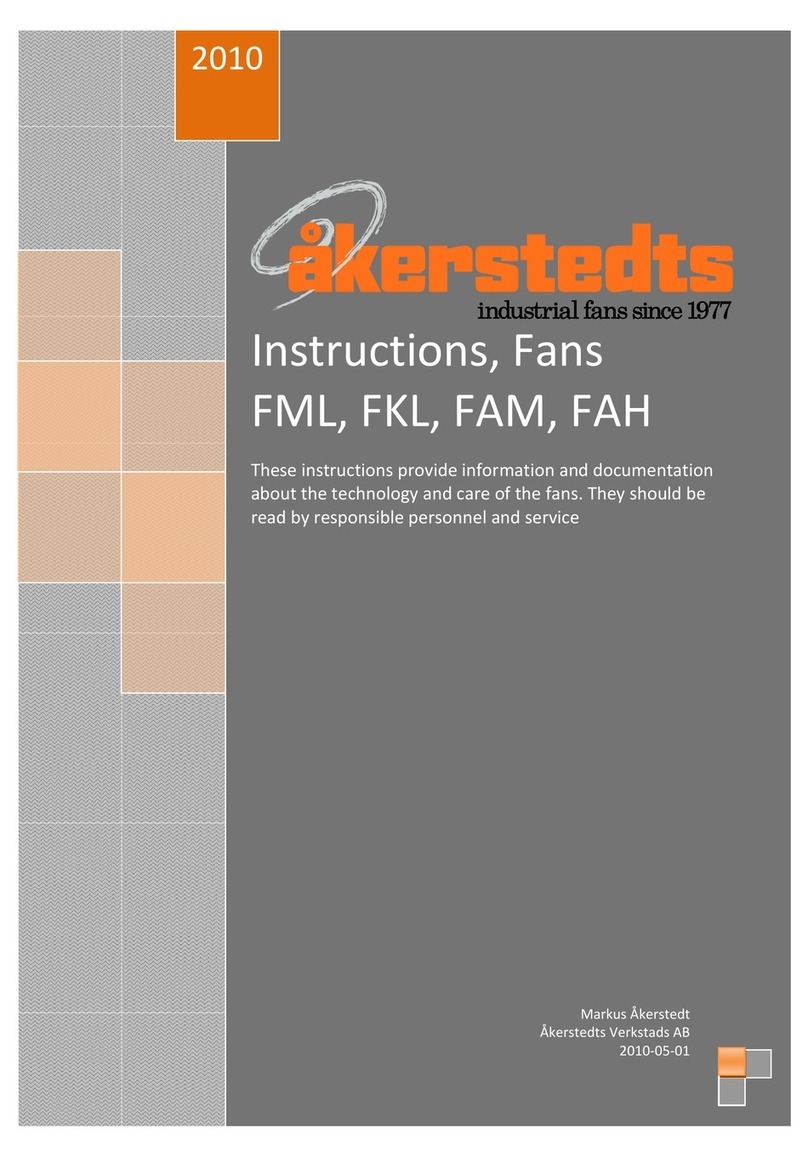
Akerstedts
Akerstedts FML instructions
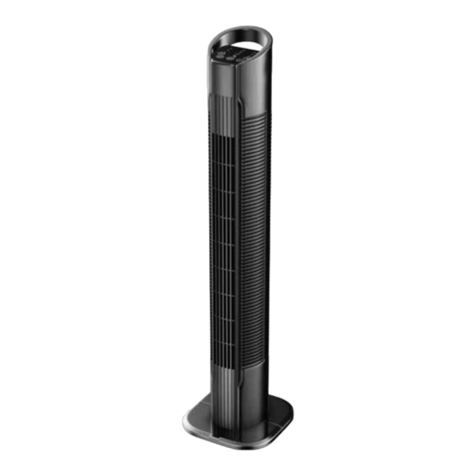
Sencor
Sencor SFT 3113BK Translation of the original user manual
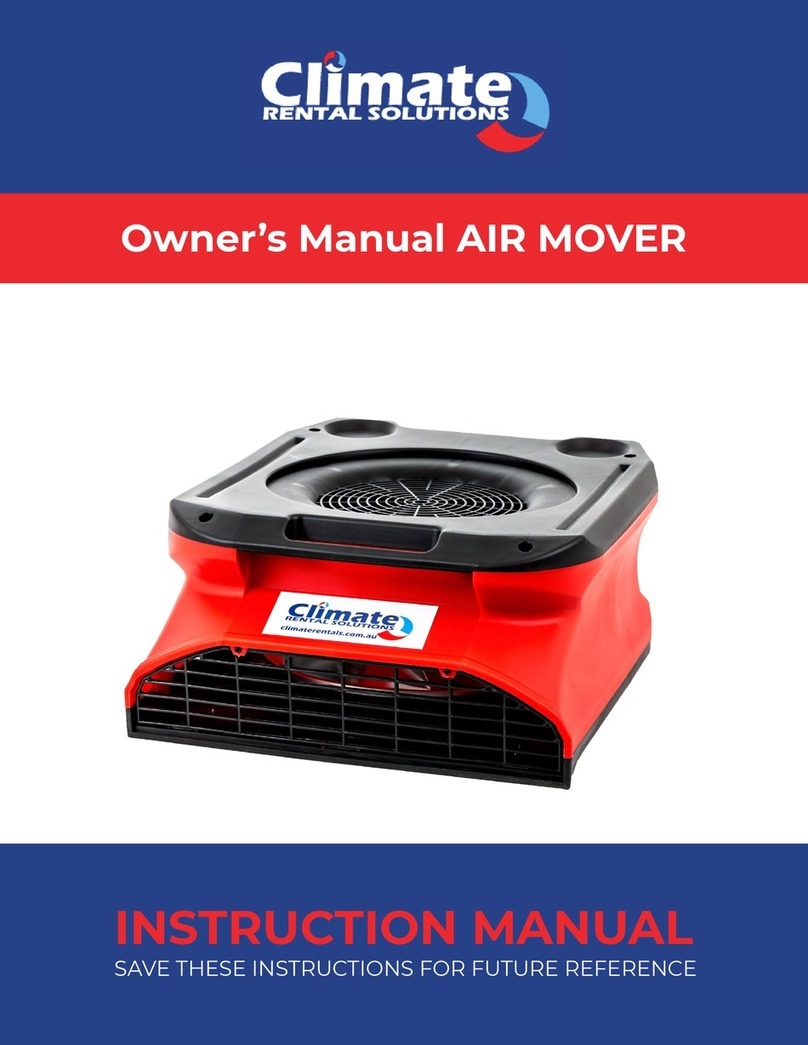
Climate RENTAL SOLUTIONS
Climate RENTAL SOLUTIONS AM 100 owner's manual
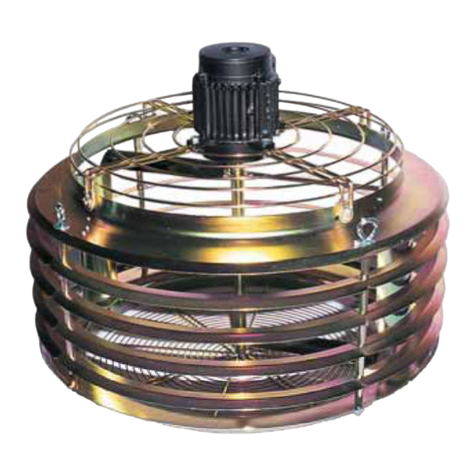
Dravo
Dravo KING Installation, operation & maintenance instructions
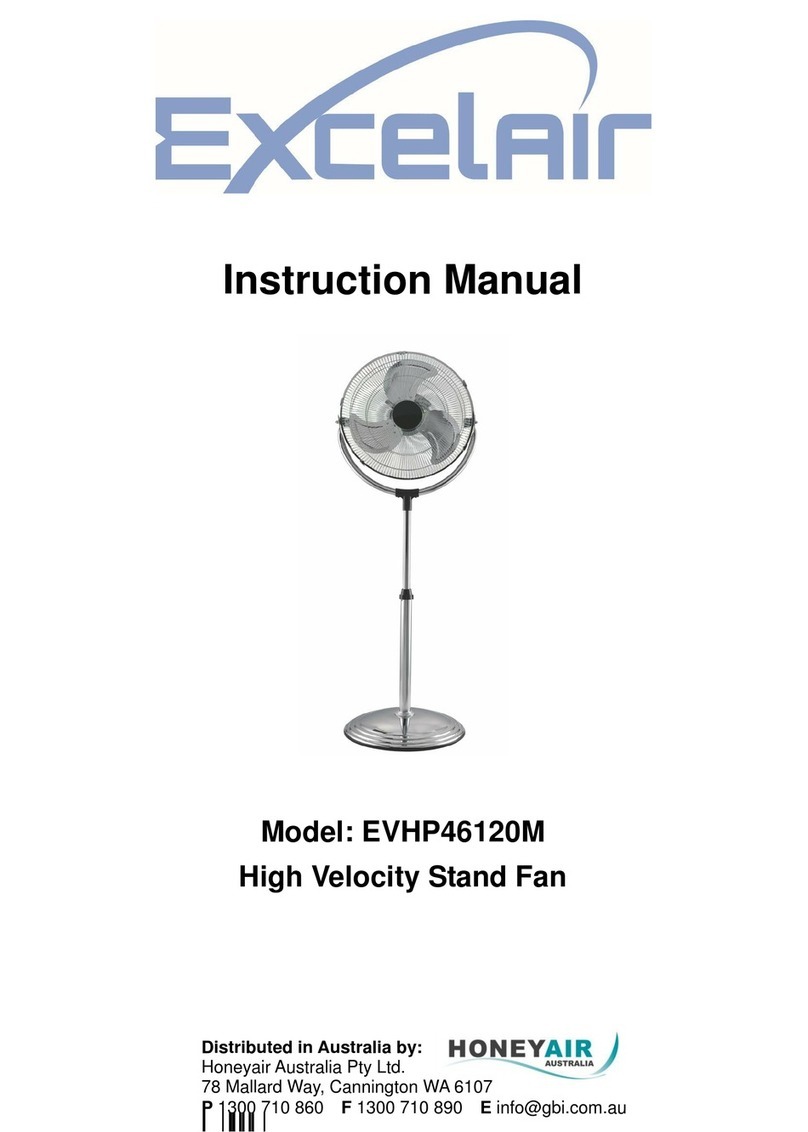
Excelair
Excelair EVHP46120M instruction manual

Nordic
Nordic HVLS Series Standard Installation Manual

Kichler Lighting
Kichler Lighting Bellamy instruction manual

Kiwi
Kiwi KFAN 7509 instruction manual

Ebmpapst
Ebmpapst K3G400-AQ23-01 operating instructions
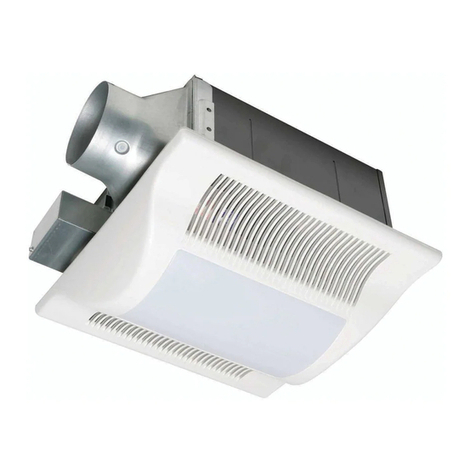
Panasonic
Panasonic Whisper-Lite FV-08VQL4 installation instructions
